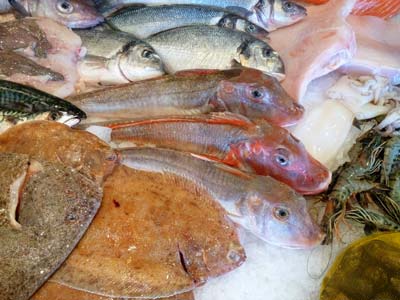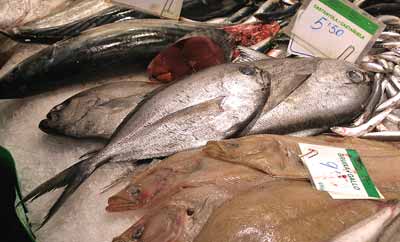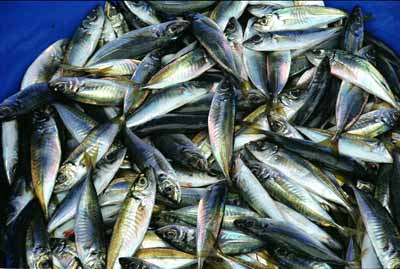
Gurnard. Gurnards are strange-looking, scaly, bottom-feeding fish with spikes which use the three bottom rays of their pectoral fins to "feel" the sea bed. They have firm-textured white meat with not much flavour, and are rich in protein, iodine and phosphorus. They emit a strange grunting noise and some make good eating. The grey gurnard (Eutrigla gurnardus) has a brownish-grey back and silver belly. The red gurnard (Aspitrigla cuculus) is the most attractive member of the family with pinkish-red colour and the finest flavour of the gurnards. The tub gurnard (Trigla lucerna) is a large brownish-orange variety with bright orange pectoral fins and is the one most readily available in the United Kingdom. There is a variety known as flying gurnard as it is a fine swimmer which sometimes leaps out of the water. They are all very bony fish. Small ones are excellent in soup. Red or grey mullet (US: striped mullet) can generally be subsituted for it, and are usually better.

Gurnard. Gurnards are strange-looking, scaly, bottom-feeding fish with spikes which use the three bottom rays of their pectoral fins to "feel" the sea bed. They have firm-textured white meat with not much flavour, and are rich in protein, iodine and phosphorus. They emit a strange grunting noise and some make good eating. The grey gurnard (Eutrigla gurnardus) has a brownish-grey back and silver belly. The red gurnard (Aspitrigla cuculus) is the most attractive member of the family with pinkish-red colour and the finest flavour of the gurnards. The tub gurnard (Trigla lucerna) is a large brownish-orange variety with bright orange pectoral fins and is the one most readily available in the United Kingdom. There is a variety known as flying gurnard as it is a fine swimmer which sometimes leaps out of the water. They are all very bony fish. Small ones are excellent in soup. Red or grey mullet (US: striped mullet) can generally be subsituted for it, and are usually better.

"Chestnut fish", because of its colour. Ray’s bream. A type of sea bream or porgy. Confusingly, in the US this is known as pomfret which, in the UK, is a quite different fish.

Scad, jack or horse mackerel. The tough part near the tail must be removed before cooking. Fish which have a firm tail section and bright eyes are the ones to select. They are at their best from spring to autumn (US: fall). In Japan they are used for sashimi or sushi and may also be grilled, simmered or deep-fried.